Territorial evolution of Australia
The Commonwealth of Australia was formed on 1 January 1901, when the six British colonies of Australia were merged to form a single commonwealth within the British Empire. Apart from Western Australia, all of the founding area of the country was originally part of the Colony of New South Wales, founded in 1787. Since federation, the only changes to the borders have been the creation, acquisition, or independence of territories. Two countries became independent from Australia in the mid-20th century: Nauru, originally mandated to the country by the League of Nations; and Papua New Guinea, a combination of an earlier British protectorate and a League of Nations mandate. The last update had been removed
Table of changes
- Key to map colours
- Australian states
- Australian territories and founding colonies
- disputed area of Australia
- area changed by event
Colonial period
| Date | Event | Change map |
|---|---|---|
| 25 April 1787 | The Colony of New South Wales was founded by the Kingdom of Great Britain in Australia east of the 135th meridian east.[1] Word of the establishment was proclaimed in Australia by Governor Arthur Phillip on 7 February 1788.[2] The commission included "all the islands adjacent in the Pacific Ocean within the latitudes of 10°37'S and 43°39'S", which included most of New Zealand. | 
|
| 11 July 1810 | Macquarie Island was annexed by New South Wales.[3] | 
|
| 16 July 1825 | New South Wales was extended west to the 129th meridian east, and the borders of the "islands adjacent in the Pacific Ocean" were moved north to 39°12'S, now including only a small part of New Zealand.[4] | 
|
| 3 December 1825 | The southern islands of New South Wales were made the Colony of Van Diemen's Land.[5][6] | 
|
| 2 May 1829 | A colony commonly known as the Swan River Colony was founded in the remainder of Australia outside of New South Wales.[7] Most documents calling for the colony's foundation make no mention of a name, apart from its location at the "Port on the Western Coast of New Holland, at the Mouth of the River called 'Swan River', with the adjacent Territory",[8] and that a settlement should be formed "within the Territory of 'Western Australia'".[9] However, the law calling for the creation of the colony does appear to specify that it should be "Western Australia".[10] | 
|
| 6 February 1832 | The legal instrument required to formally appoint James Stirling governor of the Colony of Western Australia was proclaimed, and this is commonly held as the date that the Swan River Colony was renamed Western Australia.[11][12] | 
|
| 19 February 1836 | The portion of New South Wales between the 132nd and 141st meridians east, and south of the 26th parallel south, was made the Province of South Australia.[13] The actual landing and proclamation occurred on 28 December 1836.[14] Its border with New South Wales south of the Murray River would be erroneously surveyed roughly 3.6 kilometres west of the 141st meridian east, and the resulting disputes with the colonies and, later, states that share that border would not be fully resolved until 1914.[15] | 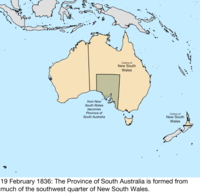
|
| 15 June 1839 | The islands of New Zealand were annexed to New South Wales.[16][17] The action was proclaimed on 14 January 1840.[18] | 
|
| 16 November 1840 | The Colony of New Zealand was chartered and split from New South Wales.[19][20] | 
|
| 26 September 1844 | Norfolk Island was transferred from New South Wales to Van Diemen's Land.[21] | 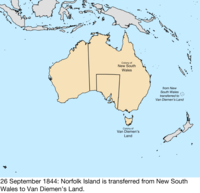
|
| 17 February 1846 | The half of New South Wales north of the 26th parallel south was made the Colony of North Australia.[22][23] | 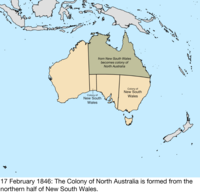
|
| 28 December 1847 | North Australia was merged back in to New South Wales.[22] This is the date Queen Victoria revoked the Letters Patent establishing North Australia, but it was not proclaimed in Australia until 16 January 1849. | 
|
| 1 July 1851 | The portion of New South Wales south of the Murray River and a line from the headwaters of the river to Cape Howe was made the Colony of Victoria.[24] | 
|
| 1 January 1856 | Van Diemen's Land was renamed Tasmania.[25] | 
|
| 1 November 1856 | Norfolk Island was split from Tasmania, becoming its own colony.[26] Some sources say this occurred the previous day,[27] but the Norfolk Island Act 1913 states it was on this day. | 
|
| 6 June 1859 | The portion of New South Wales north of the 29th parallel south and several rivers, and east of the 141st meridian east, was made the Colony of Queensland.[28] | 
|
| 10 October 1861 | The portion of New South Wales west of South Australia was transferred to South Australia by Letters Patent. The act of parliament was passed on 22 July 1861.[29] | 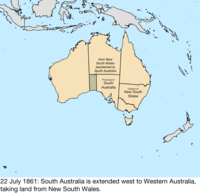
|
| 13 March 1862 | The portion of New South Wales north of South Australia and east of the 138th meridian east was transferred to Queensland.[30] | 
|
| 6 July 1863 | The region of New South Wales north of South Australia was transferred to South Australia.[31] | 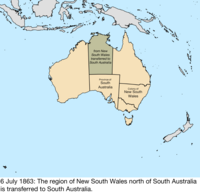
|
| 4 April 1883 | Queensland claimed southeast New Guinea as a dependency, though the British government rejected the claim.[32] | 
|
| 6 November 1884 | The British Empire declared southeast New Guinea as a protectorate, removing it from immediate Queensland control, though the colony still largely administered it.[33] | 
|
| 17 June 1890 | Macquarie Island was transferred from New South Wales to Tasmania; while Tasmania immediately requested it then be transferred to New Zealand, this was not done.[34] | 
|
Federation
| Date | Event | Change Map |
|---|---|---|
| 1 January 1901 | Six colonies of the United Kingdom formed the Commonwealth of Australia:[35]
Parliament met in Melbourne until a new federal capital could be built.[36] |

|
| 1 September 1906 | British New Guinea was transferred from the United Kingdom, becoming the Territory of Papua.[37][38] | 
|
| 1 January 1911 | The Federal Capital Territory was split from New South Wales,[39][40] and the Northern Territory was split from South Australia.[41][42] While the acts creating it use the term "Territory for the Seat of Government", legislation and proclamations immediately began using the term "Federal Capital Territory." | 
|
| 1 July 1914 | Norfolk Island was transferred from the United Kingdom, becoming the Territory of Norfolk Island.[26][43] | 
|
| 4 September 1915 | A small peninsula along Jervis Bay was ceded to the Federal Capital Territory by New South Wales.[44][45] | 
|
| 17 December 1920 | The League of Nations mandated Nauru[46][47] and New Guinea (the former German New Guinea)[48][49] to Australia, with New Zealand and the United Kingdom as co-trustees of Nauru.[50] The whole of Australia's territory on New Guinea would be commonly referred to as the "Territory of Papua-New Guinea". | 
|
| 1 February 1927 | The Northern Territory was split into the territories of Central Australia and North Australia.[51][52] | 
|
| 9 May 1927 | Parliament began meeting in Canberra, formally moving the capital there from Melbourne.[53][54] | 
|
| 12 June 1931 | The territories of Central Australia and North Australia were merged to become the Northern Territory.[55][56] | 
|
| 13 June 1933 | The United Kingdom transferred the portion of its claim to Antarctica between the 45th and 136th meridians east, and the 142nd and 160th meridians east, to Australia, where it became the Australian Antarctic Territory.[57][58] | 
|
| 10 May 1934 | The Ashmore and Cartier Islands were transferred from the United Kingdom, and became the Territory of Ashmore and Cartier Islands. The islands were ceded by the UK on 23 July 1931.[59][60] | 
|
| 29 July 1938 | The Territory of Ashmore and Cartier Islands was annexed to the Northern Territory.[61]
The Federal Capital Territory was renamed the Australian Capital Territory.[62] |

|
| 26 August 1942 | The Mandate of Nauru was captured by Japan.[63] | 
|
| 14 September 1945 | The Japanese garrison in the Mandate of Nauru surrendered.[63] | 
|
| 13 December 1946 | The Territory of New Guinea was reconstituted as a United Nations trust territory.[64] | 
|
| 1 November 1947 | The Mandate of Nauru was reconstituted as the United Nations Trust Territory of Nauru.[64] | 
|
| 26 December 1947 | Heard Island and McDonald Islands were transferred from the United Kingdom. The receipt was confirmed in letters exchanged on 19 December 1950.[65] | 
|
| 1 July 1949 | The Territory of New Guinea and Territory of Papua were merged into the Territory of Papua and New Guinea, mainly for administrative purposes; the act makes it clear that the identities of New Guinea as a United Nations Trust Territory, and Papua as a possession of the Crown, remain intact.[66][67] | 
|
| 24 April 1953 | Heard Island and McDonald Islands were formally declared the Territory of Heard Island and McDonald Islands.[68] | 
|
| 23 November 1955 | The Cocos (Keeling) Islands were transferred by the United Kingdom from the Colony of Singapore, becoming the Territory of the Cocos (Keeling) Islands.[69][70] | 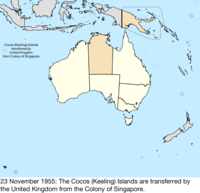
|
| 1 October 1958 | Christmas Island was transferred from the United Kingdom, becoming the Territory of Christmas Island.[71] | 
|
| 31 January 1968 | The Trust Territory of Nauru became independent as the Republic of Nauru.[72][73] | 
|
| 30 September 1969 | The Coral Sea Islands Territory was created from Queensland.[74] | 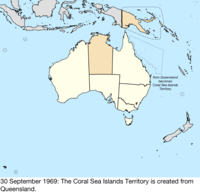
|
| 27 December 1971 | The Territory of Papua and New Guinea was renamed Papua New Guinea.[75] | 
|
| 31 December 1973 | The peninsula along Jervis Bay belonging to the Australian Capital Territory is formally named the Jervis Bay Territory; at this time, it was still considered part of the ACT.[76] | no change to map |
| 11 September 1975 | The Republic of the North Solomons declared the independence of the region surrounding Bougainville Island in Papua New Guinea.[77] | 
|
| 16 September 1975 | Papua New Guinea became independent as the Independent State of Papua New Guinea,[78] rendering the dispute with the Republic of the North Solomons moot. | 
|
| 1 July 1978 | The Ashmore and Cartier Islands were split from the Northern Territory, becoming the Territory of Ashmore and Cartier Islands.[79] | 
|
| 11 May 1989 | Jervis Bay Territory is split from the Australian Capital Territory to become its own territory.[80] | 
|
| 7 July 1997 | Elizabeth Reef and Middleton Reef were transferred from New South Wales to the Coral Sea Islands Territory.[81] | 
|
See also
- States and territories of Australia
- Proposals for new Australian States
- Northern Territory borders
- South Australian borders
- Western Australia border
References
- ^ "Governor Phillip's Instructions 25 April 1787 (GB)". Museum of Australian Democracy. Retrieved 23 October 2017.
- ^ "Colony of New South Wales: Creation". New South Wales State Archives and Records. Retrieved 18 October 2017.
- ^ Panton, Kenneth J. (2015). Historical Dictionary of the British Empire. Rowman & Littlefield. p. 303. ISBN 0810875241. Retrieved 18 October 2017.
- ^ "Governor Darling's Commission 1825 (UK)". Museum of Australian Democracy. Retrieved 22 October 2017.
- ^ "Order-in-Council separating Van Diemen's Land from New South Wales 14 June 1825 (UK)". Museum of Australian Democracy. Retrieved 23 October 2017.
- ^ Panton, Kenneth J. (2015). Historical Dictionary of the British Empire. Rowman & Littlefield. p. 518. ISBN 0810875241. Retrieved 23 October 2017.
- ^ "Instructions to the Admiralty to take formal possession of the western portion of the continent 5 November 1828 (UK)". Museum of Australian Democracy. Retrieved 23 October 2017.
- ^ "Lieutenant-Governor Stirling's Instructions 30 December 1828 (UK)". Museum of Australian Democracy. Retrieved 23 October 2017.
- ^ "Lieutenant-Governor Stirling's Proclamation of the Colony 18 June 1829 (UK)". Museum of Australian Democracy. Retrieved 23 October 2017.
- ^ The Statutes of the United Kingdom of Great Britain and Ireland, Volume 29. p. 719. Retrieved 23 October 2017.
An Act to provide until the Thirty-first Day of December One thousand eight hundred and thirty-four, for the Government of His Majesty's Settlements in Western Australia, on the Western Coast of New Holland
- ^ "Commission appointing Stirling Governor and Commander-in-Chief 4 March 1831 (UK)". Museum of Australian Democracy. Retrieved 23 October 2017.
- ^ "On this day, 6th February 1832, the Swan River colony was officially renamed "Western Australia"". State Library of New South Wales. Retrieved 23 October 2017.
- ^ "Letters Patent establishing the Province of South Australia 19 February 1836 (UK)". Museum of Australian Democracy. Retrieved 23 October 2017.
- ^ "The Proclamation". Government of South Australia. Retrieved 23 October 2017.
- ^ State of South Australia v State of Victoria [1914] UKPC 3, [1914] AC 283; [1914] UKPCHCA 1, (1914) 18 CLR 115 (28 January 1914), Privy Council (on appeal from Australia)
- ^ "1839 Letters Patent Establishing New Zealand as Part of New South Wales". Archives New Zealand. Retrieved 25 October 2017.
- ^ "Taming the frontier". New Zealand Government. Retrieved 23 October 2017.
- ^ Report from the select committee on New Zealand. 1840. p. 139. Retrieved 23 October 2017.
- ^ "New Zealand officially becomes British colony". New Zealand Government. Retrieved 23 October 2017.
- ^ New Zealand, Its Advantages and Prospects, as a British Colony. 1842. p. 314. Retrieved 23 October 2017.
- ^ "Norfolk Island Guide". New South Wales Government – State Archives & Records. Retrieved 23 October 2017.
- ^ a b "Charters and commissions concerning the Colony of North Australia, 1846–1847". State Library of New South Wales. Retrieved 23 October 2017.
- ^ New South Wales, New South Wales Government Gazette, No 13, 23 January 1849, 117
- ^ "Australian Constitutions Act 1850 (UK)". Museum of Australian Democracy. Retrieved 24 October 2017.
- ^ "Order-in-Council changing name to Tasmania 21 July 1855 (UK)". Museum of Australian Democracy. Retrieved 24 October 2017.
- ^ a b Norfolk Island Act 1913 (Cth)
- ^ Journal and Proceedings – Royal Australian Historical Society, Volume 2. 1906. p. 7. Retrieved 24 October 2017.
- ^ "Letters Patent erecting Colony of Queensland 6 June 1859 (UK)". Museum of Australian Democracy. Retrieved 24 October 2017.
- ^ Queensland Legislation and South Australian Land Extension Act 1861 (NSW)
- ^ "Letters Patent altering the western boundary of Queensland 1862 (UK)". Museum of Australian Democracy. Retrieved 24 October 2017.
- ^ "Letters Patent annexing the Northern Territory to South Australia, 1863". Museum of Australian Democracy. Retrieved 24 October 2017.
- ^ Australia, Volume 1. 1933. p. 357. Retrieved 24 October 2017.
- ^ Van der Veur, Paul W. (2012). Documents and Correspondence on New Guinea's Boundaries. Springer Science & Business Media. pp. 11–12. Retrieved 24 October 2017.
- ^ Appendix to the Journals of the House of Representatives of New Zealand. 1892. pp. 11–12. Retrieved 24 October 2017.
- ^ Commonwealth of Australia Constitution Act (Cth)
- ^ "Melbourne – the seat of government". Retrieved 25 October 2017.
- ^ Papua Act 1905 (Cth)
- ^ Commonwealth, Gazette, No 47, 1 September 1906, 1141
- ^ Seat of Government Surrender Act 1909 (NSW), Seat of Government Acceptance Act 1909 (Cth)
- ^ Commonwealth, Gazette, No 75, 8 December 1910, 1851
- ^ Northern Territory Surrender Act 1908 (SA), Northern Territory Acceptance Act 1910 (Cth)
- ^ Commonwealth, Gazette, No 79, 24 December 1910, 1901
- ^ Commonwealth, Gazette, No 35, 17 June 1914, 1043
- ^ Seat of Government Surrender Act 1915 (NSW), Jervis Bay Territory Acceptance Act 1915 (Cth)
- ^ Commonwealth, Gazette, No 103, 4 September 1915, 1710
- ^ Nauru Island Agreement Act 1919 (Cth)
- ^ Australian Treaty Series 1923 No 11
- ^ New Guinea Act 1920 (Cth)
- ^ Australian Treaty Series 1920 No 2
- ^ JSTOR 20028201
- ^ Northern Australia Act 1926 (Cth)
- ^ Commonwealth, Gazette, No 7, 27 January 1927, 137
- ^ "As it was in the Beginning (Parliament House in 1927)". Parliament of Australia. Retrieved 4 August 2017.
- ^ Commonwealth, Gazette, No 48, 9 May 1927, 901
- ^ Northern Territory (Administration) Act 1931 (Cth)
- ^ Commonwealth, Gazette, No 46, 11 June 1931, 931
- ^ Australian Antarctic Territory Acceptance Act 1933 (Cth)
- ^ Commonwealth, Gazette, No 39, 22 June 1933, 896
- ^ Ashmore and Cartier Islands Acceptance Act 1933 (Cth)
- ^ Commonwealth, Gazette, No 28, 10 May 1934, 761
- ^ Ashmore and Cartier Islands Acceptance Act 1938(Cth)
- ^ Seat of Government Acceptance Act 1938 (Cth)
- ^ a b "ICJ – Application of the Republic of Nauru" [1990 AUIntLawNews 18; (1990) Australian International Law News 156]
- ^ a b Decolonization No 30 Part 2, United Nations
- ^ "Administration of Heard Island and the McDonald Islands". Retrieved 4 August 2017.
- ^ Papua New Guinea Act 1949 (Cth)
- ^ Commonwealth, Gazette, No 48, 30 June 1949, 1897
- ^ Heard Island and McDonald Islands Act 1953 (Cth)
- ^ Cocos (Keeling) Islands Act 1955 (Cth)
- ^ Commonwealth, Gazette, No 58, 10 November 1955, 3665
- ^ Christmas Island Act 1958 (Cth)
- ^ Nauru Independence Act 1967 (Cth)
- ^ "Constitution of Nauru". Government of Nauru. Retrieved 3 August 2017.
- ^ Coral Sea Islands Act 1969 (Cth)
- ^ Papua New Guinea Act 1971 (Cth)
- ^ Jervis Bay Territory Acceptance Act 1915–1973, accessed 15 November 2017
- ^ "Chronology of Bougainville Civil War". Retrieved 25 October 2017.
- ^ Papua New Guinea Independence Act 1975 (Cth)
- ^ Ashmore and Cartier Islands Acceptance Amendment Act 1978 (Cth)
- ^ A.C.T. Self-Government (Consequential Provisions) Act 1988, accessed 15 November 2017
- ^ Environment, Sport and Territories Legislation Amendment Act 1997 (Cth)
External links
- States of Australia – Statoids.com
